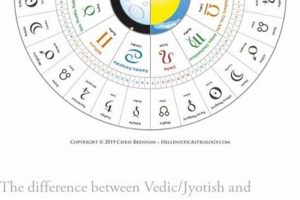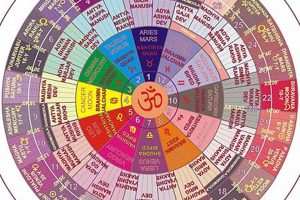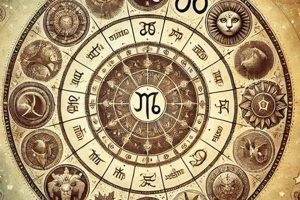
This ancient Indian system of celestial interpretation calculates planetary positions based on the fixed stars, contrasting with tropical systems that use the vernal equinox as a reference point. This fixed-star basis results... Read more »

In Vedic astrology, the sign occupied by the Sun at the time of an individual’s birth determines their solar sign. When the Sun is transiting the eighth sign of the zodiac, Vrishchika,... Read more »

In Vedic astrology, Shani, often equated with the Roman god Saturn, represents karma, discipline, and time. This celestial body governs structure, limitations, and lessons learned through experience. A prominent placement might manifest... Read more »

Within the tradition of Vedic astrology, the celestial sphere is divided into 27 lunar mansions known as nakshatras. Each segment spans 13 degrees and 20 minutes, forming a vital component of astrological... Read more »

In Vedic astrology, a planetary conjunction occurs when two or more planets occupy the same sign within the zodiac. Specifically, a Mercury-Jupiter alignment represents the meeting of the planets of communication and... Read more »

In Vedic astrology, the South Node of the Moon is known as Ketu. Unlike the other planets, it’s a shadow point, a calculated position rather than a physical celestial body. This shadowy... Read more »

In Vedic astrology, the south lunar node is considered a shadowy planet, a point of intersection where the Moon’s orbit crosses the ecliptic plane. This celestial point, without physical form, is associated... Read more »

Vedic astrology, rooted in ancient Indian scriptures, offers a system for understanding personality, predicting life events, and navigating life’s challenges based on planetary positions at the time of birth. Applying this system... Read more »

In Vedic astrology, Brihaspati, known as the Guru (teacher), represents wisdom, knowledge, prosperity, and spiritual growth. This celestial body governs higher learning, philosophy, religion, and law. A strong placement can indicate an... Read more »

Vedic astrology, originating in ancient India, uses sidereal astronomical calculations to chart planetary positions. Applying this system to the year 2000 provides a snapshot of celestial influences believed to impact individuals and... Read more »


